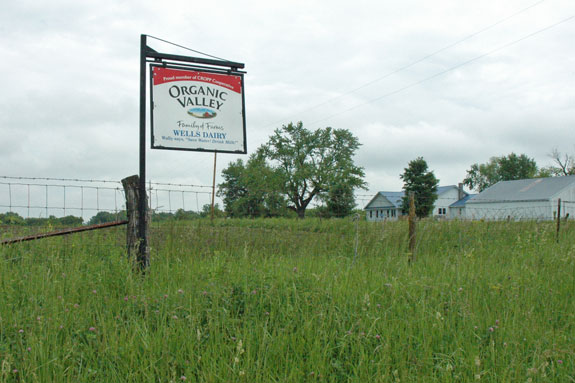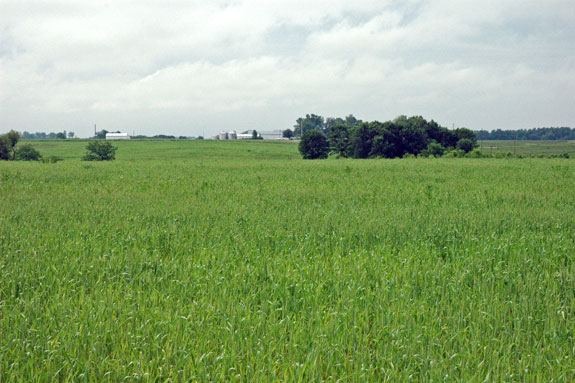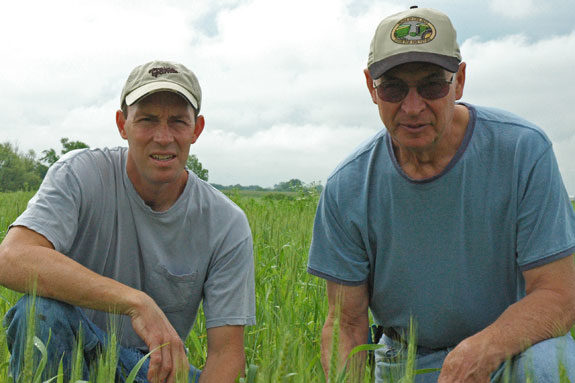Wells Dairy, not to be confused with the makers of Blue Bunny® Ice Cream, is a father-son operation that first certified organic cropland in 1993, and just recently certified the dairy in 2008.
Father, Paul, and son, Jason, farm about 1,000 acres of certified organic pasture and cropland as well.
Certified organic crop producers are required to grow row crops no more than three years in a five-year rotation. This isn’t an issue for the Wellses, though. According to Paul, their rotation is typically soybeans-corn-soybeans-small grain and then multiple years of hay.
“Our rotation will never be a five-year rotation,” said Paul. “We’ll always grow hay multiple years [for grazing].”
Cover Crops
A major issue with growing row crops organically is weed invasion. Jason Wells says their fields get particularly weedy by the third consecutive row crop year. That’s how cover crops help.

In fall 2009, they aerial-applied wheat and red clover to standing soybeans to reduce weeds and erosion, limit nitrogen leaching, increase soil organic matter and improve overall soil quality.
“We are very happy with the wheat and clover,” said Jason. “We tried to plant a rye cover crop in the past, and it got away from us.”
With no experience applying cover crops aerially, Jason says he was skeptical during the winter months whether the wheat/clover cover crop would come in this spring, but he was pleasantly surprised.
“If you were out here this February you could barely tell we seeded cover crops this year, but they just shot up this spring,” he said.
A major reason why they aerial applied the wheat and clover was a wetter than normal fall, which included a late soybean harvest. The cover crops were applied in late October, more than a month later than recommended.
And with a wet spring, the Wellses didn’t cultivate the cover crops and plant corn until mid-June. They plan to aerial apply cover crops again this year, but this time in late August or early September.
The family farmers offset the cost of applying cover crops after signing up for the USDA’s Organic Initiative through the Environmental Quality Incentives Program (EQIP).
Administered by the Natural Resources Conservation Service (NRCS), the Program offers already-certified organic producers assistance for applying new conservation practices to treat a natural resource concern, and offers participants transitioning to organic agriculture assistance to protect natural resources while meeting their certification goals.

The Wells’ EQIP Organic Initiative contract includes 300 acres of cover crops and 730 acres of pest management through 2012.
“With the wet ground, we wouldn’t have even applied cover crops without the assistance of the Organic Initiative through EQIP,” said Jason. “It really worked for us and helped our operation through a wet fall and spring, which can be tough for organic farmers.”
Conservation Stewardship Program
In addition to their EQIP contracts, the Wellses also signed a Conservation Stewardship Program (CSP) contract this year including 590 acres of cropland and 30 acres of pasture. CSP encourages producers to address resource concerns by undertaking additional conservation activities and improving and maintaining existing conservation systems.
Their CSP contract includes monitoring key grazing areas on pasture and plant tissue testing to improve nitrogen management on cropland, says Aaron Musselman, NRCS resource conservationist in Van Buren County.
For more information about the EQIP Organic Initiative, visit www.ia.nrcs.usda.gov/programs/stateeqip.html or visit your local NRCS office located at the USDA Service Center.
PHOTOS
TOP: Son Jason Wells, left, influenced his dad Paul, right, to transition to certified organic production.
MIDDLE: The Wellses send their milk to Organic Valley in Wisconsin.
BOTTOM: The Wellses were getting anxious to get this wheat and red clover cover crop cultivated for corn planting. Photos by Jason Johnson.
Jason Johnson
Public Affairs Specialist
USDA Natural Resources Conservation Service









